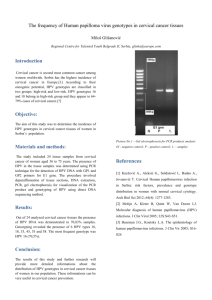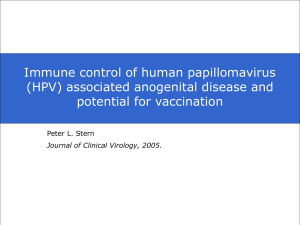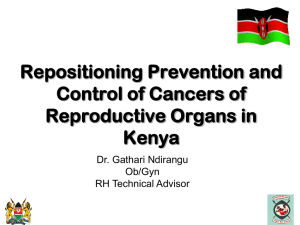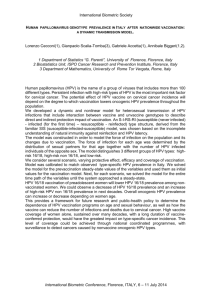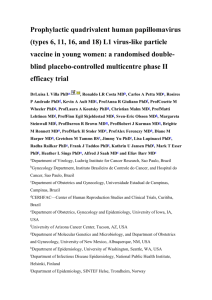0907038
advertisement
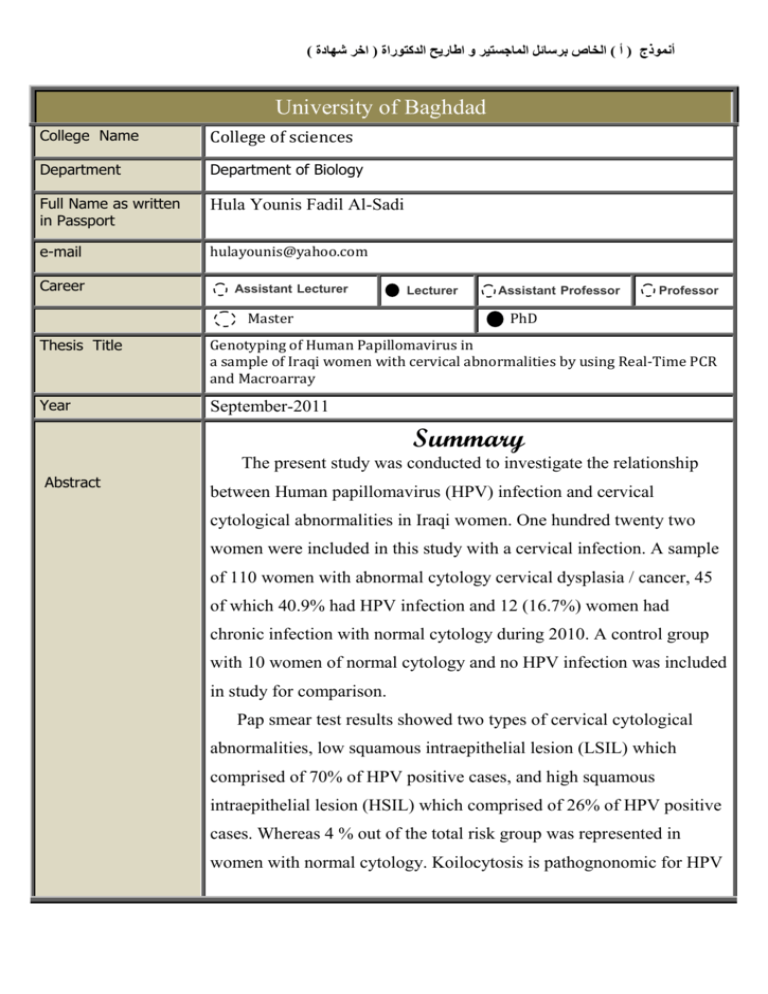
) أنموذج ( أ ) الخاص برسائل الماجستير و اطاريح الدكتوراة ( اخر شهادة University of Baghdad College Name College of sciences Department Department of Biology Full Name as written in Passport Hula Younis Fadil Al-Sadi e-mail hulayounis@yahoo.com Career Assistant Lecturer Master Lecturer Assistant Professor Professor PhD Thesis Title Genotyping of Human Papillomavirus in a sample of Iraqi women with cervical abnormalities by using Real-Time PCR and Macroarray Year September-2011 Summary The present study was conducted to investigate the relationship Abstract between Human papillomavirus (HPV) infection and cervical cytological abnormalities in Iraqi women. One hundred twenty two women were included in this study with a cervical infection. A sample of 110 women with abnormal cytology cervical dysplasia / cancer, 45 of which 40.9% had HPV infection and 12 (16.7%) women had chronic infection with normal cytology during 2010. A control group with 10 women of normal cytology and no HPV infection was included in study for comparison. Pap smear test results showed two types of cervical cytological abnormalities, low squamous intraepithelial lesion (LSIL) which comprised of 70% of HPV positive cases, and high squamous intraepithelial lesion (HSIL) which comprised of 26% of HPV positive cases. Whereas 4 % out of the total risk group was represented in women with normal cytology. Koilocytosis is pathognonomic for HPV ) أنموذج ( أ ) الخاص برسائل الماجستير و اطاريح الدكتوراة ( اخر شهادة infection. Furthermore, Koilocytosis was accompanied with 100% with genital wart presence and 16.7% was accompanied with flat wart presence. HPV-DNA studied using Real-Time PCR and MacroArray assay (GenoArray) which applied for the first time in Iraq indicates the presence of HPV-DNA in 35.6% of all tested groups. Results indicate the presence of 17 different HPV genotypes among 47 infected women by using macroarray technique. Fourteen of these HPV genotypes which comprised of 82.35% were high risk (HR-type) and 17.56% (3/17) were low risk (LR-type).One of the important results in the present study indicates the presence of ten different genotypes which may be recorded for first time in Iraqi women (HPV-31, -44, -45, -51, 52, -53, -58, -59, -66 and -68 types). Out of 17 genotypes HPV-16 was the predominant one, this genotype together with genotypes 59, 6, 39 and 66 comprised of the five most common types detected in HPV positive cases. Moreover, percentage of HPV-16, and -59 were extended to involve women with normal cytology. Seven different genotypes -6, -11, 16, 59, -39, -66 and -44 have been identified in genital wart specimens. Results indicated that 32 (68.09%) out of 47 infected women had HR type alone, whether single or multiple types, while eight women (17.02%) had HR types in association with LR types and seven women (14.89%) had LR type only. Transmission electron microscope (TEM) was used for viral particles detection from ten HPV DNA positive samples with different cytological changes. Results indicated the presence of viral particles in six samples with different grades of disease and four samples showed no viral particles. ) أنموذج ( أ ) الخاص برسائل الماجستير و اطاريح الدكتوراة ( اخر شهادة To evaluate the immune status of patients lymphocyte transformation assay was applied. Results indicated that transformed lymphocyte were found to be high in women with normal cytology which may have HPV as a latent infection, while they were decreased in women with abnormal cytology. Approximately 40% of genital wart cases have higher mean of proliferative T cell response when they were compared with control group. However, proliferative T cell responses were statistically independent on HPV infection type, viral load and aging group. Real-time PCR assay was employed for HPV detection and quantitation (viral load estimation) from the range of HR-HPV DNA 13 genotypes most frequently found in different grades of cervical intraepithelial neoplasia, cervical tumors and health controls from (132 samples). Results showed that out of 47 positive cases 35 cases can be detected by real-time PCR which comprised of 74.5%. Failures in detection by this technique included 12 cases which comprised of 25.5% of the positive samples. Therefore, viral DNA copies number for the most HR-HPV types in cervical samples was determined from 35 sample with low and high-grade cervical intraepithelial neoplasia (CIN I, II, III and Squamous Cell Carcinoma), and with normal cytology. However, the viral load of the 33 samples spread over a wide range from 1×10 to 9.4×106 copies/ml (mean 4.17×104 copies/ml). In addition, two samples were around the standard curve values as: approximately 5×107 and 1×109 copies/ml considered. Viral load was estimated approximately 46% constituted as high viral load, 34% as low viral load and 20% as slightly high viral load. ) أنموذج ( أ ) الخاص برسائل الماجستير و اطاريح الدكتوراة ( اخر شهادة Macroarray was applied in 68 samples, 36 of which were positive and 32 were negative by the real-time PCR test. High-risk genotypes were found in 35/36 (97%) real-time PCR positive samples, whereas remaining two samples were negative for HPV DNA (false-positive) by macroarray assay. The low-risk and probable high-risk (PHR) HPV genotypes were detected in the 35 HPV-positive samples which are not detected by real-time PCR included genotypes: HPV-6 (in three samples), -11, -53 and -66 (in two samples for each). HR, PHR and LR HPV genotypes were detected by macroarray in the 11/31 HPV-negative samples in real-time PCR which comprised of genotypes: -39, -58, -66, -11, -6 and -44. The GenoArray (GA) is capable of detecting 21 HPV multiple genotypes, including 8 types not detecting in real-time PCR. These types represented 32.84% of HPV types frequency and 33.33% of HPV positive cases had multiple types, this may reflect the important factor potentially favoring the GA for HPV detection. Therefore, the GA genotyping assay appears to be more accurate and sensitive technique for the detection and genotyping of HPV infections than real-time PCR one.

